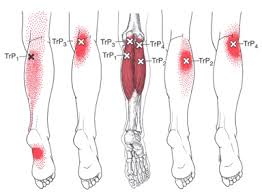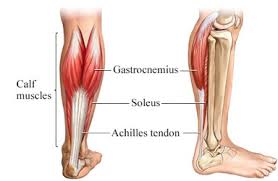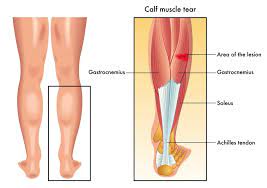

We have all heard about the effects of poor posture, especially forward head posture (FHP), on the neck, shoulders, and back.
But it was not until I found myself dealing with unexpectedly tight calf muscles that I started to connect the dots between my slumped-forward neck and the tension in my legs.
Forward head posture does more than just impact your upper body; it creates a ripple effect down the entire kinetic chain, leading to increased tension and stiffness in places you wouldn’t expect—like the calves.
In this article, BestForwardHeadPostureFix research experts will explain how forward head posture alters calf muscle tension, making them stiff and sore, and why this happens.
Using both personal experience and scientific evidence, we shall break down how poor posture in your upper body can create lower body issues, including calf muscle stiffness and pain.
In This Article:
- What Is Forward Head Posture?
- The Kinetic Chain: How Your Head Impacts Your Legs
- How Forward Head Posture Creates Muscle Tension in the Calves
- Neural Tension and Calf Pain: The Hidden Connection
- Daily Habits That Worsen Forward Head Posture and Calf Tension
- Why Muscle Stiffness in the Calves Is Linked to Posture
- The Domino Effect: How Other Muscles Contribute to Calf Muscle Stiffness
- Conclusion: Understanding the Full Body Impact of Forward Head Posture
What Is Forward Head Posture?
Forward head posture (FHP) is a common postural misalignment where the head juts forward in relation to the spine, placing excessive strain on the neck and upper back muscles.
Over time, this poor alignment throws off the body’s balance, causing compensations that affect muscles further down the body.
If you spend hours hunched over a screen or frequently tilt your head forward, chances are you have experienced FHP to some degree.
At first glance, it may seem unrelated to your legs, but as we shall soon explore, this head-forward positioning can create a chain reaction that ultimately affects calf muscle tension.
The Kinetic Chain: How Your Head Impacts Your Legs?
In the world of biomechanics, the body is often referred to as a kinetic chain, meaning that changes in one part of the body can affect distant areas.
Forward head posture may start at the neck, but it throws off the entire spinal alignment, causing changes in how we stand and move.
When your head moves forward, your body compensates by shifting its weight, often leading to altered gait and foot placement.
When you stand with a forward head, your center of gravity shifts, forcing your lower body muscles to work harder to maintain balance.
The calves, in particular, take on additional strain because they are essential in stabilizing the ankles and maintaining an upright posture.
This extra load leads to calf muscle tension over time.
How Forward Head Posture Creates Muscle Tension in the Calves
When I first noticed my calf muscles becoming stiff and sore after long hours at the desk, it did not make sense at first.
I wasn’t doing any intense lower body exercises. The connection became clearer when I paid attention to my posture.
Bad neck posture was altering how my body balanced itself, and my calves were working overtime to compensate.
Research has shown that forward head posture causes a shift in the pelvis and lower back, which, in turn, puts more strain on the legs, particularly the calf muscles.
This extra strain manifests as muscle tension in the calf, as these muscles engage to stabilize the body in its altered posture.
Over time, this leads to the familiar feeling of stiffness and soreness in the calves, even though the problem originates much higher up in the body.
Neural Tension and Calf Pain: The Hidden Connection
One of the lesser-known effects of nerd neck posture is its impact on neural tension.
The body’s nerves, especially the sciatic nerve, can be affected by poor posture.
Bad neck posture increases tension along the spine, which can lead to neural tension calf pain.
Essentially, this means the nerves running from the lower back to the legs become irritated or compressed, causing pain and tightness in the calf muscles.
In my own experience, I noticed that stretching my calves only offered temporary relief.
The real issue was the neural tension caused by my forward head posture.
This connection between the head and the lower body highlights how intricately linked our posture is to the function and comfort of our legs.
Daily Habits That Worsen Forward Head Posture and Calf Tension
In today’s digital age, many of us spend long hours looking down at smartphones, computers, or slumping in chairs.
These habits contribute to forward head posture, but they also increase tension in the calf muscles.
Sitting for extended periods with poor neck posture tightens the hip flexors, hamstrings, and ultimately places more strain on the calves.
Even standing for long periods in a forward head position, as I often found myself doing during work presentations, contributes to calf muscle stiffness and pain.
The body is constantly trying to balance, and the calves take the brunt of the effort in stabilizing you.
So, even though it may seem like the problem is just in your neck, your daily habits are putting additional strain on your lower legs.
Why Muscle Stiffness in the Calves Is Linked to Posture
Muscle stiffness in the calf is a direct result of the overcompensation that happens when forward head posture throws off your body’s alignment.
When your upper body is misaligned, the muscles in the calves work harder to stabilize you, which leads to muscle tension in the calf over time.
The longer you maintain forward head posture, the more your calves tighten, leading to lower leg muscle stiffness.
I noticed this especially after a full day of sitting with poor posture—by the evening, my calves would be tight and achy, even though
I had not engaged them in any significant activity.
Scientific research backs this up, showing that prolonged text neck can contribute to chronic tension in lower extremity muscles, particularly the calves (Journal of Bodywork and Movement Therapies).
The Domino Effect: How Other Muscles Contribute to Calf Muscle Stiffness?
Turtle neck posture does not just affect the calves in isolation.
The entire chain of muscles, from your back down to your feet, plays a role in calf muscle tension.
For instance, when the hips and hamstrings become tight due to forward head posture, the calves are forced to overcompensate, leading to increased muscle stiffness in the calf.
I found that stretching my hamstrings helped relieve calf tension and improve thigh muscle imbalance caused by forward neck, but only temporarily.
The real issue was that my forward head posture was causing a domino effect of tightness and muscle imbalances, with the calves being one of the primary victims.
As your body tries to compensate for poor posture, muscles like the hamstrings, glutes, and even the lower back can contribute to calf tension.
The calves, being one of the key stabilizers, bear the burden of this misalignment.
Takeaway: Understanding the Full Body Impact of Crane Neck Posture
In conclusion, Crane neck posture does not just affect your neck or shoulders—it can have a profound impact on your lower body, particularly your calf muscles.
The body’s kinetic chain means that when one part of the body is out of alignment, other areas must compensate, leading to muscle stiffness and pain in seemingly unrelated areas like the calves.
The tension in calf muscles caused by forward head posture happens due to the body’s need to stabilize itself.
Over time, this extra load creates stiff and sore calf muscles, making movement and recovery more difficult.
In my own experience, addressing the posture issue was key to relieving calf muscle tension.
Stretching and strengthening the calves alone was not enough.
I had to tackle the root cause—my forward head posture.
By understanding how posture affects the entire body, including the lower legs, we can start to make changes that relieve calf tension and prevent future discomfort.
References:


